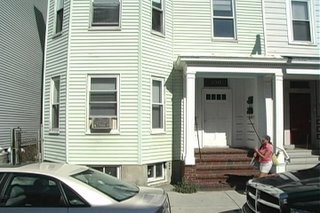It seems that Amazon is paying online lurkers two cents per image to pick the best image from severa l to represent a business in their online directory. I propose this to anyone who is concerned about the low pay of architecture. At 4000 images a day, that is $80 each day AS A CREDIT TO YOUR ACCOUNT, meaning tax free! Yippee, sign me up. So, the bottom of the barrel at this point is:
1.bum in manhattan ($24000 take home - or take wherever)
2.amazon.com image sifter ($19200 in copies of LOST season 2 that you have to sell on half.com)
3.full time architect out of school ($23000 before uncle sam)
So, generous side note notwithstanding, there are definitely applications (that will pay) for rule based design guides. As I was driving through suburbia yesterday, I realized how useful a database may be to officials or other infrastructure planners.
What if we could submit the style information of each house to the local fire department? Instantly they would know what rooms were bedrooms and where the children were. On a small screen in the truck would appear a plan, sections (maybe with all modifications, etc.) on a secure system. Privacy isn't an issue, as plans are already typically available at building official offices.
 So much is available to the public - court records, public domain literary classics, tax info, arrest reports, and ip domain ownership that the problem is an overload of incompatibility. Similarly, I can write email from my computer, my phone, my GPS system in the car (if I had one), and soon to be - my digital camera, so there is going to have to be a use for all this interconnectivity. What if I could take a picture of a building, like this thing in downtown Boston that I don't recognize, and instantly have information available on it? What if I could connect digitally to the company through a data 'port'? It would make visiting a lot easier - a store could digitally broadcast it's specials, operating hours, anything they wanted - but you would be able to get the informaiton on your phone or camera, whatever. The problem is that while we have 802.11b standards, firewire standards, Joliet standards for DVDs, there are no connection standards for the world. Our interaction is primarily visual.
So much is available to the public - court records, public domain literary classics, tax info, arrest reports, and ip domain ownership that the problem is an overload of incompatibility. Similarly, I can write email from my computer, my phone, my GPS system in the car (if I had one), and soon to be - my digital camera, so there is going to have to be a use for all this interconnectivity. What if I could take a picture of a building, like this thing in downtown Boston that I don't recognize, and instantly have information available on it? What if I could connect digitally to the company through a data 'port'? It would make visiting a lot easier - a store could digitally broadcast it's specials, operating hours, anything they wanted - but you would be able to get the informaiton on your phone or camera, whatever. The problem is that while we have 802.11b standards, firewire standards, Joliet standards for DVDs, there are no connection standards for the world. Our interaction is primarily visual.
<- My house on a9.com - scary
So, there is a famous problem given by a computer science professor at MIT annually, to freshman majors. They are asked to write a program that is able to recognize what is shown in any picture. There have been great advances in the professional world, b ut students come to realize how difficult it is. Really interesting is this software that can give you limited directions based on an image. They key will always be integration, and I'm not talking about my refrigerator writing me an email about my rotten eggs. There ARE uses.
No comments:
Post a Comment